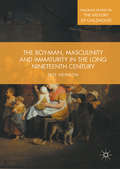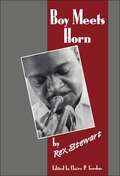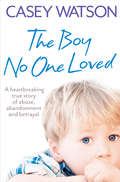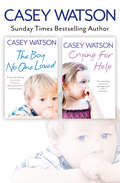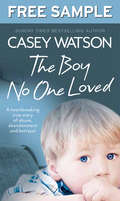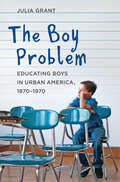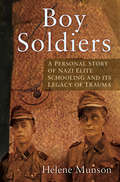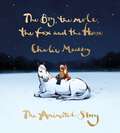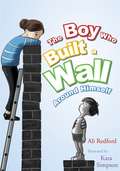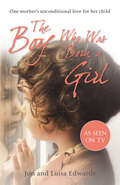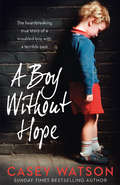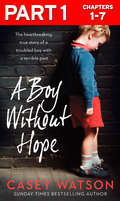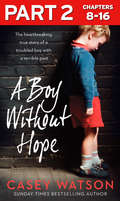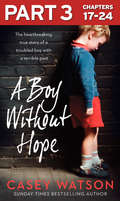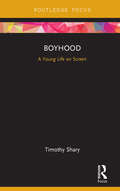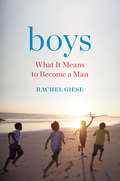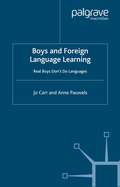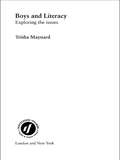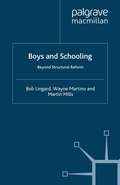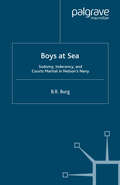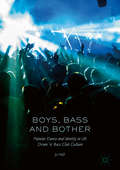- Table View
- List View
The Boy-Man, Masculinity and Immaturity in the Long Nineteenth Century (Palgrave Studies in the History of Childhood)
by Pete NewbonThis book explores the evolution of male writers marked by peculiar traits of childlike immaturity. The ‘Boy-Man’ emerged from the nexus of Rousseau’s counter-Enlightenment cultural primitivism, Sensibility’s ‘Man of Feeling’, the Chattertonian poet maudit, and the Romantic idealisation of childhood. The Romantic era saw the proliferation of boy-men, who congregated around such metropolitan institutions as The London Magazine. These included John Keats, Leigh Hunt, Charles Lamb, Hartley Coleridge, Thomas De Quincey and Thomas Hood. In the period of the French Revolution, terms of childishness were used against such writers as Wordsworth, Keats, Hunt and Lamb as a tool of political satire. Yet boy-men writers conversely used their amphibian child-adult literary personae to critique the masculinist ideologies of their era. However, the growing cultural and political conservatism of the nineteenth century, and the emergence of a canon of serious literature, inculcated the relegation of the boy-men from the republic of letters.
Boy Meets Horn
by Rex StewartOne of the most innovative and inventive soloists in jazz, cornetist Rex Stewart (1907-67) became known as a writer on jazz subjects. This work, his autobiography drafted at the time of his death, has been edited from its manuscript sources by Stewart's amanuensis, who edited his earlier posthumous collection Jazz Masters of the Thirties. With a selection of rare photographs from Stewart's own archive, and mss. facsimiles.
The Boy No One Loved: A Heartbreaking True Story Of Abuse, Abandonment And Betrayal
by Casey WatsonSunday Times bestselling author and foster carer Casey Watson’s first heartbreaking memoir. Justin was five years old; his brothers two and three. Their mother, a heroin addict, had left them alone again. Later that day, after trying to burn down the family home, Justin was taken into care.
The Boy No One Loved and Crying for Help 2-in-1 Collection
by Casey WatsonSunday Times bestselling author and foster carer Casey Watson’s first heartbreaking memoir The Boy No One Loved now combined in a single volume with her shocking title Crying for Help about a troubled 12-year-old girl.
The Boy No One Loved: Free Sampler
by Casey WatsonDiscover the incredible memoirs of internationally bestselling author Casey Watson with this free extended eBook sampler of Casey’s first book, and Sunday Times bestseller, The Boy No One Loved.
The Boy Problem: Educating Boys in Urban America, 1870–1970
by Julia GrantAmerica’s educational system has a problem with boys, and it’s nothing new.The question of what to do with boys—the "boy problem"—has vexed educators and social commentators for more than a century. Contemporary debates about poor academic performance of boys, especially those of color, point to a myriad of reasons: inadequate and punitive schools, broken families, poverty, and cultural conflicts. Julia Grant offers a historical perspective on these debates and reveals that it is a perennial issue in American schooling that says much about gender and education today.Since the birth of compulsory schooling, educators have contended with what exactly to do with boys of immigrant, poor, minority backgrounds. Initially, public schools developed vocational education and organized athletics and technical schools as well as evening and summer continuation schools in response to the concern that the American culture of masculinity devalued academic success in school. Urban educators sought ways to deal with the "bad boys"—almost exclusively poor, immigrant, or migrant—who skipped school, exhibited behavioral problems when they attended, and sometimes landed in special education classes and reformatory institutions. The problems these boys posed led to accommodations in public education and juvenile justice system.This historical study sheds light on contemporary concerns over the academic performance of boys of color who now flounder in school or languish in the juvenile justice system. Grant's cogent analysis will interest education policy-makers and educators, as well as scholars of the history of education, childhood, gender studies, American studies, and urban history.
The Boy Problem: Educating Boys in Urban America, 1870–1970
by Julia GrantAmerica’s educational system has a problem with boys, and it’s nothing new.The question of what to do with boys—the "boy problem"—has vexed educators and social commentators for more than a century. Contemporary debates about poor academic performance of boys, especially those of color, point to a myriad of reasons: inadequate and punitive schools, broken families, poverty, and cultural conflicts. Julia Grant offers a historical perspective on these debates and reveals that it is a perennial issue in American schooling that says much about gender and education today.Since the birth of compulsory schooling, educators have contended with what exactly to do with boys of immigrant, poor, minority backgrounds. Initially, public schools developed vocational education and organized athletics and technical schools as well as evening and summer continuation schools in response to the concern that the American culture of masculinity devalued academic success in school. Urban educators sought ways to deal with the "bad boys"—almost exclusively poor, immigrant, or migrant—who skipped school, exhibited behavioral problems when they attended, and sometimes landed in special education classes and reformatory institutions. The problems these boys posed led to accommodations in public education and juvenile justice system.This historical study sheds light on contemporary concerns over the academic performance of boys of color who now flounder in school or languish in the juvenile justice system. Grant's cogent analysis will interest education policy-makers and educators, as well as scholars of the history of education, childhood, gender studies, American studies, and urban history.
Boy Soldiers: A Personal Story of Nazi Elite Schooling and its Legacy of Trauma
by Helene MunsonAt the end of the Second World War, hundreds of thousands of German children were sent to the front lines in the largest mobilisation of underage combatants by any country before or since. Hans Dunker was just one of these children. Identified as extremely gifted aged 9, he left his home in South America in 1937 in pursuit of a ‘proper’ education in Nazi Germany. Instead, he and his schoolfriends, lacking adequate training, ammunition and rations, were sent to the Eastern Front when the war was already lost in the spring of 1945. Using her father’s diary and other documents, Helene Munson traces Hans’ journey from a student at Feldafing School to a soldier fighting in Zawada, a village in present-day Czech Republic. What is revealed is an education system so inhumane that until recently, post-war Germany worked hard to keep it a secret. This is Hans’ story, but also the story of a whole generation of German children who silently carried the shame of what they suffered into old age. It reveals the true cost and long-lasting impacts of such experiences – not just to them, but also to their families and future generations, a warning to a world where thousands of child soldiers are still sent to fight in armed conflicts.
The Boy, the Mole, the Fox and the Horse: The Animated Story
by Charlie MackesyA journey, in search of homeCharlie Mackesy's beloved The Boy, the Mole, the Fox and the Horse has been adapted into an animated short film, coming to BBC One and iPlayer this Christmas.This beautifully made hardback celebrates the work of over 100 animators across two years of production - with Charlie's distinctive illustrations brought to life in full colour with hand-drawn traditional animation and accompanying hand-written script."I made a film with some friends about a boy, a mole, a fox and a horse - their journey together and the boy's search for home. I hope this book gives you courage and makes you feel loved." Love Charlie x
The Boy Who Built a Wall Around Himself (PDF)
by Ali Redford Kara SimpsonBoy built a wall to keep himself safe. Behind it he felt strong and more protected. Then Someone Kind came along. She bounced a ball, sang and painted on the other side of the wall, and Boy began to wonder if life on the other side might be better after all. Written for children aged 4 to 9, this gentle full-colour picture book uses a simple metaphor to explain how children who have had painful or traumatic experiences can build barriers between themselves and other people. It will help children explore their feelings and encourage communication.
The Boy Who Was Born a Girl: One Mother’s Unconditional Love for Her Child
by Jon Edwards Luisa EdwardsBrought up as female for fifteen years, Jon can remember feeling different from other girls since he was only five years old. But it will take years of depression, incessant bullying, self-harm and isolation before he discovers why.When Jon eventually confides to his mother that he feels like a boy, Luisa commits herself unconditionally to helping her child.For Jon, the changes that follow are his path to happiness. But for Luisa, this means coming to terms with the enormous loss of her daughter.
A Boy Without Hope
by Casey WatsonA BOY WITHOUT HOPE is the heart-breaking story of a boy who didn’t know the meaning of love. A history of abuse and neglect has left Miller destined for life’s scrap heap. But in this turbulent story of conflict and struggle, Casey Watson is determined to help Miller overcome his demons, show him love and give him hope.
A Boy Without Hope: Part 1 of 3
by Casey WatsonA BOY WITHOUT HOPE is the heart-breaking story of a boy who didn’t know the meaning of love. A history of abuse and neglect has left Miller destined for life’s scrap heap. But in this turbulent story of conflict and struggle, Casey Watson is determined to help Miller overcome his demons, show him love and give him hope.
A Boy Without Hope: Part 2 of 3
by Casey WatsonA BOY WITHOUT HOPE is the heart-breaking story of a boy who didn’t know the meaning of love. A history of abuse and neglect has left Miller destined for life’s scrap heap. But in this turbulent story of conflict and struggle, Casey Watson is determined to help Miller overcome his demons, show him love and give him hope.
A Boy Without Hope: Part 3 of 3
by Casey WatsonA BOY WITHOUT HOPE is the heart-breaking story of a boy who didn’t know the meaning of love. A history of abuse and neglect has left Miller destined for life’s scrap heap. But in this turbulent story of conflict and struggle, Casey Watson is determined to help Miller overcome his demons, show him love and give him hope.
Boyhood: A Young Life on Screen (Cinema and Youth Cultures)
by Timothy SharyThis book traces the development of Richard Linklater’s Boyhood from its audacious concept through its tenacious production to its celebrated reception, placing it within the context of cinematic parables about children to demonstrate its distinctive vision. Timothy Shary, author of numerous studies on the history of teen cinema, evaluates the film’s many messages about youth and adolescence within the context of early twenty-first century American culture, illuminating how Linklater’s singular vision of the otherwise ordinary life of a boy reveals potent universal truths about all people.
Boyhood: A Young Life on Screen (Cinema and Youth Cultures)
by Timothy SharyThis book traces the development of Richard Linklater’s Boyhood from its audacious concept through its tenacious production to its celebrated reception, placing it within the context of cinematic parables about children to demonstrate its distinctive vision. Timothy Shary, author of numerous studies on the history of teen cinema, evaluates the film’s many messages about youth and adolescence within the context of early twenty-first century American culture, illuminating how Linklater’s singular vision of the otherwise ordinary life of a boy reveals potent universal truths about all people.
Boys: What It Means to Become a Man
by Rachel GieseA vital and sweeping examination of today's "boy crisis," demonstrating the ways in which we raise boys into a culture of toxic masculinity and offering solutions that can liberate us allWhether they're being urged to "man up" or warned that "boys don't cry," young men are subjected to damaging messages about manliness: they must muzzle their emotions and never show weakness, dominate girls and compete with one another.Boys: What It Means to Become a Man examines how these toxic rules can hinder boys' emotional and social development. If girls can expand the borders of femaleness, could boys also be set free of limiting, damaging expectations about manhood and masculinity? Could what's been labelled "the boy crisis" be the beginning of a revolution in how we raise young men? Drawing on extensive research and interviews with educators, activists, parents, psychologists, sociologists, and young men, Giese--mother to a son herself--examines the myths of masculinity and the challenges facing boys today. She reports from boys-only sex education classes and recreational sports leagues; talks to parents of transgender children and plays video games with her son. She tells stories of boys navigating the transition into manhood and how the upheaval in cultural norms about sex, sexuality and the myths of masculinity have changed the coming of age process for today's boys. With lively reportage and clear-eyed analysis, Giese reveals that the movement for gender equality has the potential to liberate us all.
Boys Adrift: The Five Factors Driving the Growing Epidemic of Unmotivated Boys and Underachieving Young Men
by Leonard SaxWhy America's sons are underachieving, and what we can do about it.Something is happening to boys today. From kindergarten to college, American boys are, on average, less resilient and less ambitious than they were a mere twenty years ago. The gender gap in college attendance and graduation rates has widened dramatically. While Emily is working hard at school and getting A's, her brother Justin is goofing off. He's more concerned about getting to the next level in his videogame than about finishing his homework.In Boys Adrift, Dr. Leonard Sax delves into the scientific literature and draws on more than twenty years of clinical experience to explain why boys and young men are failing in school and disengaged at home. He shows how social, cultural, and biological factors have created an environment that is literally toxic to boys. He also presents practical solutions, sharing strategies which educators have found effective in re-engaging these boys at school, as well as handy tips for parents about everything from homework, to videogames, to medication.
Boys and Foreign Language Learning: Real Boys Don't Do Languages
by J. Carr A. PauwelsThe authors examine the continuing poor relationship between boys and the study of foreign languages. Framed by discussion of gender socialization, gendered curriculum practices and cultural narratives about boys and schooling, the core of the book is constructed by boys themselves.
Boys and Literacy: Exploring the Issues (Language and Literacy in Action)
by Trisha MaynardIn recent years the issue of boys and literacy, namely that they are worse at it compared to girls, has become a key area of interest to all those concerned with the education of our children. This book highlights the key factors causing this divide and discusses the implementation of new strategies to overcome it, which have been the result of extensive qualitative research made by the author. Trisha Maynard reports case study findings of a primary school whose staff wanted to explore and improve boys' attitudes towards and attainment in literacy, and in particular their difficulties with writing.The book highlights issues concerning the reading and writing of stories, what teachers understand by 'good story writing' and the importance of teachers exploring boys' and girls' difficulties with literacy by themselves. It provides significant insight into boys' difficulties with writing as well as informing teachers how to find out about children's attainment.
Boys and Literacy: Exploring the Issues (Language and Literacy in Action)
by Trisha MaynardIn recent years the issue of boys and literacy, namely that they are worse at it compared to girls, has become a key area of interest to all those concerned with the education of our children. This book highlights the key factors causing this divide and discusses the implementation of new strategies to overcome it, which have been the result of extensive qualitative research made by the author. Trisha Maynard reports case study findings of a primary school whose staff wanted to explore and improve boys' attitudes towards and attainment in literacy, and in particular their difficulties with writing.The book highlights issues concerning the reading and writing of stories, what teachers understand by 'good story writing' and the importance of teachers exploring boys' and girls' difficulties with literacy by themselves. It provides significant insight into boys' difficulties with writing as well as informing teachers how to find out about children's attainment.
Boys and Schooling: Beyond Structural Reform
by B. Lingard W. Martino M. MillsExploring current approaches to addressing boys' education in schools, this book highlights the limitations of structural reform initiatives and the failure to address the impact of socioeconomic status, race, sexuality, disability and hegemonic masculinity on both boys' and girls' participation in schooling.
Boys at Sea: Sodomy, Indecency, and Courts Martial in Nelson's Navy
by B. BurgBoys at Sea is a study of homoerotic life in the Royal Navy during the age of sail. The book traces every feature of sexual life at sea, including seduction, rape, prostitution, courts martial, and the punishments meted out to those convicted of violating the stern moral code set down in the Articles of War .
Boys, Bass and Bother: Popular Dance and Identity in UK Drum ’n’ Bass Club Culture 1st ed
by Jo HallThis book uses ethnographic research to examine the role of dance in the construction of identity in the distinctly British electronic dance music club culture of drum ’n’ bass. Dancing is revealed as the central way in which drum ’n’ bass clubbers construct and perform their identities, which are informed, although not defined, by the club culture’s histories. The intertextual and intercultural development of drum ’n’ bass musical and clubbing culture is shown to be represented in the dancing body, prompting a challenge to the discourse of cultural appropriation. Popular representations of identities are embodied by drum ’n’ bass clubbers through affective transmission via the popular screen, and in this process are re-valued in their embodiment. Using a socially orientated understanding of intertextuality, the popular dancing body is shown to be heterocorporeal: containing traces of prior meaning and logic yet replete with new meaning and significance.
